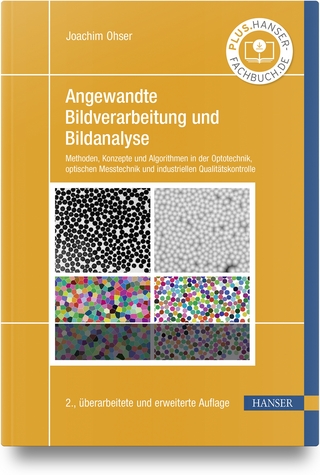
Computer Vision – ECCV 2020 Workshops
Springer International Publishing (Verlag)
978-3-030-66095-6 (ISBN)
The 249 full papers, 18 short papers, and 21 further contributions included in the workshop proceedings were carefully reviewed and selected from a total of 467 submissions. The papers deal with diverse computer vision topics.
Part II focusses on commands for autonomous vehicles; computer vision for ART analysis; sign language recognition, translation and production; visual inductive priors for data-efficient deep learning; 3D poses in the wild challenge; map-based localization for autonomous driving; recovering 6D object pose; and shape recovery from partial textured 3D scans.
W12 - Commands 4 Autonomous Vehicles.- Commands 4 Autonomous Vehicles (C4AV) Workshop Summary.- Commands for Autonomous Vehicles by Progressively Stacking Visual-Linguistic Representations.- C4AV: Learning Cross-Modal Representations from Transformers.- Cosine meets Softmax: A tough-to-beat baseline for visual grounding.- Attention Enhanced Single Stage Multimodal Reasoner.- AttnGrounder: Talking to Cars with Attention.- W13 - Computer VISion for ART Analysis.- Detecting Faces, Visual Medium Types, and Gender in Historical Advertisements, 1950-1995.- A Dataset and Baselines for Visual Question Answering on Art.- Understanding Compositional Structures in Art Historical Images using Pose and Gaze Priors.- Demographic In uences on Contemporary Art with Unsupervised Style Embeddings.- Geolocating Time: Digitisation and Reverse Engineering of a Roman Sundial.- Object Retrieval and Localization in Large Art Collections using Deep Multi-Style Feature Fusion and Iterative Voting.- W15 - Sign Language Recognition, Translation and Production.- SLRTP 2020: The Sign Language Recognition, Translation & Production Workshop.- Automatic Segmentation of Sign Language into Subtitle-Units.- Phonologically-meaningful Subunits for Deep Learning-based Sign Language Recognition.- Recognition of an effective and grammatical facial expressions: a study for Brazilian sign language.- Real-Time Sign Language Detection using Human Pose Estimation.- Exploiting 3D Hand Pose Estimation in Deep Learning-Based Sign Language Recognition from RGB Videos.- A Plan for Developing an Auslan Communication Technologies Pipeline.- A Multi-modal Machine Learning Approach and Toolkit to Automate Recognition of Early Stages of Dementia among British Sign Language Users.- Score-level Multi Cue Fusion for Sign Language Recognition.- Unsupervised Discovery of Sign Terms by K-Nearest Neighbours Approach.- Improving Keyword Search Performance in Sign Language with Hand Shape Features.- W16 - Visual InductivePriors for Data-Efficient Deep Learning.- Lightweight Action Recognition in Compressed Videos.- On sparse connectivity, adversarial robustness, and a novel model of the artificial neuron.- Injecting Prior Knowledge into Image Caption Generation.- Learning Temporally Invariant and Localizable Features via Data Augmentation for Video Recognition.- Unsupervised Learning of Video Representations via Dense Trajectory Clustering.- Distilling Visual Priors from Self-Supervised Learning.- Unsupervised Image Classi cation for Deep Representation Learning.- TDMPNet: Prototype Network with Recurrent Top-Down Modulation for Robust Object Classi cation under Partial Occlusion.- What leads to generalization of object proposals.- A Self-Supervised Framework for Human Instance Segmentation.- Multiple interaction learning with question-type prior knowledge for constraining answer search space in visual question answering.- A visual inductive priors framework for data-efficient image classification.- W18 - 3D Poses In the Wild Challenge.- Predicting Camera Viewpoint Improves Cross-dataset Generalization for 3D Human Pose Estimation.- Beyond Weak Perspective for Monocular 3D Human Pose Estimation.- W20 - Map-based Localization for Autonomous Driving.- Geographically Local Representation Learning with a Spatial Prior for Visual Localization.- W22 - Recovering 6D Object Pose.- BOP Challenge 2020 on 6D Object Localization.- StructureFromGAN: Single Image 3D Model Reconstruction and Photorealistic Texturing.- 6 DoF Pose Estimation of Textureless Objects from Multiple RGB Frames.- Semi-supervised Viewpoint Estimation with Geometry-aware Conditional Generation.- Physical Plausibility of 6D Pose Estimates in Scenes of Static Rigid Objects.- DronePose: Photorealistic UAV-Assistant Dataset Synthesis for 3D Pose Estimation via a Smooth Silhouette Loss.- How to track your dragon: A Multi-Attentional Framework for real-time RGB-D 6-DOF Object Pose Tracking.- Hybrid Approach for 6DoF Pose Estimation.- Leaping from 2D Detection to E cient 6DoF Object Pose Estimation.- W23 - SHApe Recovery from Partial Textured 3D Scans.- Implicit Feature Networks for Texture Completion from Partial 3D Data.- 3DBooSTeR: 3D Body Shape and Texture Recovery.- SHARP 2020: The 1st Shape Recovery from Partial Textured 3D Scans Challenge Results.
| Erscheinungsdatum | 05.01.2021 |
|---|---|
| Reihe/Serie | Image Processing, Computer Vision, Pattern Recognition, and Graphics | Lecture Notes in Computer Science |
| Zusatzinfo | XXVII, 759 p. 13 illus. |
| Verlagsort | Cham |
| Sprache | englisch |
| Maße | 155 x 235 mm |
| Gewicht | 1171 g |
| Themenwelt | Informatik ► Grafik / Design ► Digitale Bildverarbeitung |
| Informatik ► Theorie / Studium ► Künstliche Intelligenz / Robotik | |
| Schlagworte | Applications • Computer Science • conference proceedings • Correlation Analysis • Databases • Education • face recognition • Human-Computer Interaction (HCI) • Image Analysis • image coding • Image Processing • image reconstruction • Image Segmentation • Informatics • machine learning • Neural networks • Object recognition • pattern recognition • Research • Robotics • Signal Processing • User Interfaces |
| ISBN-10 | 3-030-66095-8 / 3030660958 |
| ISBN-13 | 978-3-030-66095-6 / 9783030660956 |
| Zustand | Neuware |
| Haben Sie eine Frage zum Produkt? |
aus dem Bereich


